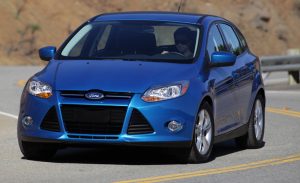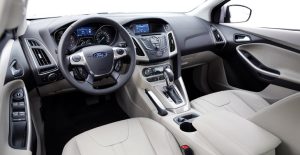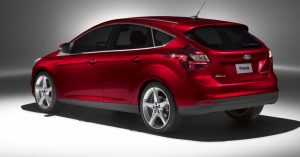- New Ford Focus combines expressive design with an exceptional array of smart new technologies, high levels of craftsmanship and occupant safety
- Focus will deliver up to a projected 40 mpg on the highway, while offering the driver engaging performance and handling
- North American Focus hatchback and sedan models will go on sale – in S, SE, SEL and Titanium trim series levels – at Ford dealerships in early 2011
The all-new Ford Focus is gearing up for its North American launch with a sporty five-door hatchback and sleek four-door sedan.
The all-new Focus will set a new standard in the small car segment, offering more technology and features than more expensive European cars, while delivering an expected 40 mpg, the only gas engine-powered vehicle with an automatic transmission in its segment to do so.
“Focus brings a desirable combination of dynamic design, outstanding driver engagement, unmatched levels of technology and impressive fuel economy,” said Mark Fields, president of The Americas. “The new model should expand Focus appeal to a whole new generation of customers.”
Focus is Ford’s most significant global nameplate. With more than 10 million units sold since launch in 1998, Focus has become a sales leader with consumers worldwide for its outstanding value, comfort, safety, technology and driving dynamics.
Following an unprecedented global development program under the company’s One Ford strategy, the all-new 2012 Focus is set to continue its successful tradition. Focus demonstrates how Ford can scale to meet the universal needs of worldwide customers, while fine-tuning to suit regional preferences.
“In every world market where Focus competes, customers are looking for expressive design, meaningful technologies, responsive performance and exceptional fuel economy,” said Derrick Kuzak, Ford group vice president of Global Product Development. “Focus will set new standards for these comparatives and offer a class-leading range of standard and available content, enabled by its global scale.”
Distinguished by its sleek and sporty design, the new Focus is packed with more affordable technologies and features than Honda Civic or Toyota Corolla or even larger competitors such as Honda Accord or Toyota Camry. In addition, Focus offers high standards of quality and craftsmanship and class-leading fuel economy, and it takes driving dynamics to a new level.
“One of every four new vehicles sold in the world today comes from this small car segment, which we anticipate will see further growth in North America,” said Jim Hughes, chief engineer. “We’re aiming to stretch Focus’ ‘brandwidth’ by adding a premium Titanium series with luxury levels of convenience and comfort, appealing to an ever-expanding spectrum of buyers.”
Developed in Europe and for sale in more than 120 markets worldwide, the all-new Focus is a key element of the North American Ford product portfolio. Building on the quality leadership of the previous model, the next-generation Focus range has been expanded to include a high-series Titanium model that will please drivers shifting from larger and luxury-class vehicles.
Striking, streamlined design
Both Focus bodystyles share a sporty character, marking the next evolution of Ford’s acclaimed kinetic design form language. With its striking front end, sleek profile, dramatic rising beltline and athletic stance, the new Focus signals the rewarding experience awaiting a driver.
The all-new Focus four-door has a drag coefficient as low as 0.297, compared to the current model’s 0.320. This is a lower drag coefficient than Chevrolet Cruze and Volkswagen Jetta. The slippery Focus shape and steeply raked windshield contribute to significantly reduced drag. Optimized aerodynamics help to reduce Focus wind noise at speed and contribute to improved fuel efficiency.
Focus features new active grille shutters to block airflow through the cooling system when not required. In addition to an aerodynamic improvement at higher speeds, active grille shutters reduce underhood temperatures at low speed, increasing thermal efficiency.
Noise, vibration and harshness (NVH) levels have been reduced and driving dynamics enhanced by the improved stiffness of the body structure, with 30 percent greater rigidity than the previous Focus model.
Stylish, functional interior
The dynamic quality of the exterior is reinforced by the distinctive design of the interior. Focus has a modern, cockpit-style interior, with a stylish center console.
The most significant interior innovation is SYNC® with MyFord Touch™, which replaces many of the traditional vehicle buttons, knobs and gauges with clear, colorful LCD screens and five-way buttons. The screens can be personalized to display information relevant to each driver using a simple button click, voice command or touch screen tap. MyFord Touch is powered by a new generation of the company’s award-winning SYNC system, which includes a sophisticated voice control system for vehicle functions, connected Bluetooth® devices, MP3 players and a wide variety of external media.
The interior combines functionality with outstanding craftsmanship. The cabin’s bold and contemporary graphics, the sculptured shape of the soft-touch instrument panel and the choice of superior trim materials combine to give occupants a premium-class experience.
Focus brings C-car interior space to a new level, rivaling larger vehicles. It offers more shoulder room than an Audi A4, and more front headroom than a Toyota Camry. In the spacious second row, Focus provides more hip room than the Audi or Toyota.
Smart technology for safety and practicality
The worldwide scale of Ford’s C-car program makes additional technologies and features more economically viable than ever for cars in this segment. This enabled Focus engineers to make a wide range of innovative technologies available to meet the diverse needs of global consumers.
While the number of features offered in each market will vary according to local customer demand and acceptance, the full range of technologies has been engineered for Focus, meaning additional features could be made available to meet changing market requirements.
Focus was designed to exceed global safety standards for occupant and pedestrian protection. Featuring next-generation front and sides airbag technologies to tailor deployment to individual passengers, Focus includes segment-exclusive Safety Canopy® curtain airbags.
The comprehensive range of smart technologies and features available on the new Focus for North America includes:
- Active park assist
- SYNC with Traffic, Directions and Information
- HD Radio™ with iTunes® Tagging
- Ambient lighting
- Torque vectoring control
- Rear view camera
- Intelligent Access with push-button start
Unmatched driving quality
The original Ford Focus brought new levels of driving agility to this segment of cars. Now Focus raises the benchmark to target class-leading driving quality, blending communicative steering with significantly improved ride quality. To achieve this, Ford engineers have optimized new designs for the Control Blade™ multilink rear suspension and semi-isolated front subframe.
The Focus chassis design is complemented by a completely new electric power-assisted steering (EPAS) system, which has been carefully tuned to deliver precise response at speed while remaining light and maneuverable for easy parking.
Ford engineers have enhanced Focus cornering stability and agility with an advanced torque vectoring control system, behaving like a limited-slip differential to constantly balance the distribution of torque between the front wheels. This results in reduced understeer, improved traction and better turn-in.
The system is particularly effective as the car accelerates through corners, applying an imperceptible amount of braking to the inside front wheel so that more of the engine torque goes to the outside wheel with greater traction. This makes the car feel smaller, more agile and responsive. Torque vectoring control provides handling characteristics that will flatter novice drivers and reward the expert ones.
Spirited performance with outstanding economy
The engaging driver appeal of the new Ford Focus is magnified by an advanced powertrain delivering spirited performance while targeting class-leading fuel economy.
Focus is fitted with a completely new 2.0-liter gasoline direct-injection DOHC four-cylinder engine that combines high-pressure direct injection and twin independent variable camshaft timing (Ti-VCT) for enhanced performance and fuel efficiency. This engine delivers more power than the current 2.0-liter Duratec® unit featured in the North American Focus, while contributing to projected fuel economy gains of more than 10 percent.
To maximize its performance and economy advantage, the engine is mated with the latest dry-clutch six-speed Ford PowerShift automatic transmission. A high-efficiency dual dry-clutch design, the transmission alone can help to reduce fuel consumption by up to 9 percent compared to a traditional four-speed automatic. This advanced transmission is also offered with SelectShift Automatic™ functionality, allowing drivers to manually control gear selection.
For drivers preferring a stick shift and clutch pedal, Focus offers a five-speed manual transmission alternative.
The all-new 2012 Ford Focus goes on sale at North American Ford dealerships in early 2011. It will be manufactured at Michigan Assembly Plant in Wayne, Mich
MATH, CREATIVE THINKING, COMPUTING POWER TO BRING SUPERIOR SHIFT QUALITY
- 2012 Ford Focus, featuring a 2.0-liter direct-injection gasoline engine and PowerShift dry-clutch six-speed automatic transmission, incorporates Ford’s patented Torque Hole Filling (THF) technology for smoother, more seamless shift quality
- THF uses a combination of mathematical modeling and computer-aided engineering tools, along with other enabling transmission technologies to deliver smoother upshifts
- Originally penned in 1986, the Ford-developed THF invention disclosure came to fruition as computing power and transmission technologies caught up with the pioneering idea
- In internal evaluations, THF improved shift quality ratings by up to 2 points (out of 10) in comparison to baseline shifts with conventional controls
The 2012 Ford Focus will offer up exceptional shift quality to drivers, powered in part by an inventive Ford transmission technology that has been waiting nearly 25 years for computing power to catch up to make it a reality.
Focus features the Ford PowerShift dry-clutch six-speed automatic transmission, one of the first transmissions to benefit from Torque Hole Filling (THF), a Ford-developed and patented concept and methodology conceived a quarter century ago. THF uses a combination of mathematical algorithms, computer-aided engineering (CAE) tools and transmission control technologies to fill what is commonly known as the torque hole – the slight hesitation drivers may feel during an upshift when there is a momentary drop in transmission torque output followed by a rise in torque.
The torque hole has been inherent to automatic transmissions since the 1940s, said Ford Research Technical Expert Chris Teslak. “Even though much work in controls and calibration has been done over the years, it has remained a major challenge,” he said.
To address this challenge, Dr. Davor Hrovat, a Ford Technical Fellow in Controls Research, authored an invention disclosure in the mid-1980s on how to coordinate engine and transmission controls to help eliminate the torque hole. Further analytical work and simulation revealed this pioneering concept was promising, but the technology needed to implement it wasn’t fully mature yet.
“Although the team has known what was needed to create smoother shifts, the actual implementation had to wait for drive-by-wire technologies, electronic throttle control and processing power to catch up to transform this inventive idea into a reality,” said Teslak, who credits THF project technical leaders Yuji Fujii and Eric Tseng, along with other core technical experts/engineers Jahan Asgari, Tom Brown, Chad Griffin, Don Levens and Brad Riedle for helping to bring THF to fruition under Hrovat’s guidance.
Enabling technologies such as electronic throttle control and improved actuators and sensors, coupled with the THF methodology, gave the team of Ford engineers the tools needed to precisely sync transmission and engine to transfer and smooth out the torque during a portion of an upshift lasting a fraction of a second. Adding that little extra torque during the shift helps fill the hole, creating a smoother drive experience for the customer.
In internal engineering evaluations using a PowerShift prototype, THF improved shift quality ratings by up to 2 points on a scale of 1 to 10 in comparison to baseline shifts with conventional controls.
“THF uses dynamic modeling and proprietary algorithms to command the additional engine torque that’s essential for maintaining driver-desired (communicated via the gas pedal) wheel torque in a precise, coordinated way with the clutch control,” said Riedle, Ford technical expert in transmission electronics.
To pre-stage this fraction-of-a-second “conversation” between engine and transmission, a certain degree of finesse, coordination and upfront knowledge of what customers perceive as a quality shift was needed. The technology also required the Ford engineering teams from several disciplines to throw away preconceived notions about conventional engine and shift controls.
In total, the team logged approximately three years or 6,000 man-hours of computer-aided mathematical modeling, simulation and analysis of engine speeds, torque and clutch capacity in only 24 months real time to prove the THF concept was production-ready.
“This methodology is the result of persistence, teamwork, creative thinking and a desire to move beyond existing shift dynamics,” said Teslak. “THF enables a consistently smooth shift feel with minimum calibration effort and no incremental hardware cost.
“More importantly, it’s a portable technology that can be applied across multiple powertrain/transmission powerpacks, giving us the ability to quickly deliver best-in-class shift quality across platforms.”
Ford has two U.S. patents covering broad THF applications and several other related patents are pending. Further research on how to most effectively incorporate THF into more conventional planetary gear-based transmissions is ongoing





